Fretting Wear Damage Mechanism of Uranium under Various Atmosphere and Vacuum Conditions
Abstract
:1. Introduction
2. Experimental Procedure
Materials and Specimens
3. Results and Discussion
4. Conclusions
- (a)
- The COF in oxygen condition is at least about 0.335, and it has a maximum wear volume of about 1.48 × 107 μm3. However, the COF in high vacuum condition is at most about 1.104, and the wear volume is 1.64 × 106 μm3.
- (b)
- The COF in a low vacuum condition is very different, which firstly increases and then decreases rapidly to a steady value. This is caused by partly abrasive wear and the formation of tribofilm after thousands of cycles.
- (c)
- With increasing vacuum degree, the COF increases and the characteristic of plastic deformation, crack, and adhesive trace becomes more obvious. With increasing oxygen content, the COF decreases due to abrasive wear and the formation of oxide film. However, the wear volume increases with increasing oxygen content.
Acknowledgments
Author Contributions
Conflicts of Interest
References
- Zhu, S.F.; Chen, L.; Wu, Y.P. Microstructure and corrosion resistance of Cr/Cr2N multilayer film deposited on the surface of depleted uranium. Corros. Sci. 2014, 82, 420–425. [Google Scholar] [CrossRef]
- Thoppul, S.D.; Finegan, J.R.; Gibson, F. Mechanics of mechanically fastened joints in polymer–matrix composite structures—A review. Compos. Sci. Technol. 2009, 69, 301–329. [Google Scholar] [CrossRef]
- Hattori, T.; Nishimura, N.; Yamashita, M. Fretting Fatigue Strength and Life Estimation Considering the Fretting Wear Process. Tribol. Int. 2007, 353, 882–885. [Google Scholar]
- Wu, Y.P.; Li, Z.Y.; Zhu, S.F.; Cai, Z.B. Effect of frequency on fretting wear behavior of Ti/TiN multilayer film on depleted uranium. PLoS ONE 2017, 12, 0175084. [Google Scholar] [CrossRef] [PubMed]
- Juoksukangas, J.; Lehtovaara, A.; Mäntylä, A. Experimental and numerical investigation of fretting fatigue behavior in bolted joints. Tribol. Int. 2016, 103, 440–448. [Google Scholar] [CrossRef]
- Zhu, M.H.; Zhou, Z.R. On the mechanisms of various fretting wear modes. Tribol. Int. 2011, 44, 1378–1388. [Google Scholar] [CrossRef]
- Cai, Z.B.; Zhu, M.H.; Zhou, Z.R. An experimental study torsional fretting behaviors of LZ50 steel. Tribol. Int. 2010, 43, 361–369. [Google Scholar] [CrossRef]
- Vingsbo, O.; Söderberg, S. On fretting maps. Wear 1988, 12, 131–147. [Google Scholar] [CrossRef]
- Zhou, Z.R.; Vincent, L. Cracking Induced by Fretting of Aluminium Alloys. J. Tribol. 1997, 119, 36–42. [Google Scholar] [CrossRef]
- Zhou, Z.R.; Nakazawa, K.; Zhu, M.H. Progress in fretting maps. Tribol. Int. 2006, 39, 1068–1073. [Google Scholar] [CrossRef]
- Hu, J.; Zhang, K.; Yang, Q. Fretting behaviors of interface between CFRP and coated titanium alloy in composite interference-fit joints under service condition. Mater. Des. 2017, 134, 91–102. [Google Scholar] [CrossRef]
- Li, Z.Y.; Cai, Z.B.; Wu, Y.P. Effect of nitrogen ion implantation dose on torsional fretting wear behavior of titanium and its alloy. Trans. Nonferr. Metal. Soc. 2017, 27, 324–335. [Google Scholar] [CrossRef]
- Wang, Z.H.; Lu, Y.H.; Li, J. Effect of pH value on the fretting wear behavior of Inconel 690 alloy. Tribol. Int. 2016, 95, 162–169. [Google Scholar] [CrossRef]
- Hirsch, M.R.; Neu, R.W. Temperature-Dependent Fretting Damage of High Strength Stainless Steel Sheets. Wear 2016, 346, 6–14. [Google Scholar] [CrossRef]
- Sawada, T.; Schille, C.; Almadani, A. Fretting Corrosion Behavior of Experimental Ti-20Cr Compared to Titanium. Materials 2017, 10, 194. [Google Scholar] [CrossRef] [PubMed]
- Wang, Q.; Wang, H.; Wang, Y. The influences of several carbon additions on the fretting wear behaviors of UHMWPE composites. Tribol. Int. 2016, 93, 390–398. [Google Scholar] [CrossRef]
- Esteves, M.; Ramalho, A.; Ramos, F. Fretting behavior of the AISI 304 stainless steel under different atmosphere environments. Tribol. Int. 2015, 88, 56–65. [Google Scholar] [CrossRef]
- Chaudhry, V.; Kailas, S.V. Damage mechanisms in stainless steel and chromium carbide coatings under controlled environment fretting conditions. Wear 2015, 334, 75–81. [Google Scholar] [CrossRef]
- Chaudhry, V.; Kailas, S.V. Fretting studies on self-mated stainless steel and chromium carbide coated surfaces under controlled environment conditions. Wear 2015, 301, 524–539. [Google Scholar] [CrossRef]
- Zhu, S.F.; Wu, Y.P.; Liu, T. Interface structure and corrosion resistance of Ti/Cr nanomultilayer film prepared by magnetron sputtering on depleted uranium. ACS Appl. Mater. Interfaces 2013, 14, 6598–6602. [Google Scholar] [CrossRef] [PubMed]
- Dobromirski, J.; Smith, I.O. Metallographic aspects of surface damage, surface temperature and crack initiation in fretting fatigue. Wear 1987, 117, 347–357. [Google Scholar] [CrossRef]
- Iwabuchi, A.; Kato, K.; Kayaba, T. Fretting properties of SUS304 stainless steel in a vacuum environment. Wear 1986, 110, 205–216. [Google Scholar] [CrossRef]
- Iwabuchi, A. Fretting wear of inconel 625 at high temperature and in high vacuum. Wear 1985, 106, 163–175. [Google Scholar] [CrossRef]
- Kim, K.; Korsunsky, A.M. Exponential evolution law of fretting wear damage in low-friction coatings for aerospace components. Surf. Coat. Technol. 2008, 202, 5838–5846. [Google Scholar] [CrossRef]
- Velkavrh, I.; Ausserer, F.; Klien, S. The effect of gaseous atmospheres on friction and wear of steel–steel contacts. Tribol. Int. 2014, 79, 99–110. [Google Scholar] [CrossRef]
- Velkavrh, I.; Ausserer, F.; Klien, S. The influence of temperature on friction and wear of unlubricated steel/steel contacts in different gaseous atmospheres. Tribol. Int. 2016, 98, 155–171. [Google Scholar] [CrossRef]
- Shuai, W.; Ma, J.; Zhu, S. High temperature tribological properties of Ti3AlC2, ceramic against SiC under different atmospheres. Mater. Des. 2015, 67, 188–196. [Google Scholar]
- Martínez, J.M.V.; Gómez, J.S.; Ponce, M.B. Effects of Laser Processing Parameters on Texturized Layer Development and Surface Features of Ti6Al4V Alloy Samples. Coatings 2017, 8, 6. [Google Scholar] [CrossRef]
- Martinez, J.M.V.; Pedemonte, F.J.B.; Galvin, M.B. Sliding Wear Behavior of UNS R56400 Titanium Alloy Samples Thermally Oxidized by Laser. Materials 2017, 10, 830. [Google Scholar] [CrossRef] [PubMed]
- Xin, L.; Lu, Y.; Sho, J.T. The comparative study on nanostructured tribolayers of Alloy 690TT subjected to fretting wear under different oxygen contents. Mater. Charact. 2017, 131, 157–167. [Google Scholar] [CrossRef]
- Pandey, C.; Saini, N.; Mahapatra, M.M. Study of the fracture surface morphology of impact and tensile tested cast and forged (C&F) Grade 91 steel at room temperature for different heat treatment regimes. Eng. Fail. Anal. 2016, 71, 131–147. [Google Scholar]
- Elżbieta, A.S.; Anita, A.; István, E.S. Recognition of uranium oxides in soil particulate matter by means of μ-Raman spectrometry. J. Nucl. Mater. 2008, 381, 278–283. [Google Scholar]
- Elorrieta, J.M.; Manara, D.; Bonales, L.J. Raman study of the oxidation in (U, Pu)O2 as a function of Pu content. J. Nucl. Mater. 2017, 495, 484–491. [Google Scholar] [CrossRef]
- Lv, J.; Luo, H.; Liang, T. Influence of pre-deformation and oxidation in high temperature water on corrosion resistance of type 304 stainless steel. J. Nucl. Mater. 2015, 466, 154–161. [Google Scholar]
- Liu, K.; Ren, B.; Hong, X. Structural analysis of nitride layer formed on uranium metal by glow plasma surface nitriding. Appl. Surf. Sci. 2013, 265, 389–392. [Google Scholar] [CrossRef]
- Chaudhry, V.; Simha, K.R.; Kailas, S.V. Energy based approach for the evaluation of damage under partial slip and gross sliding condition. Wear 2014, 315, 115–124. [Google Scholar] [CrossRef]

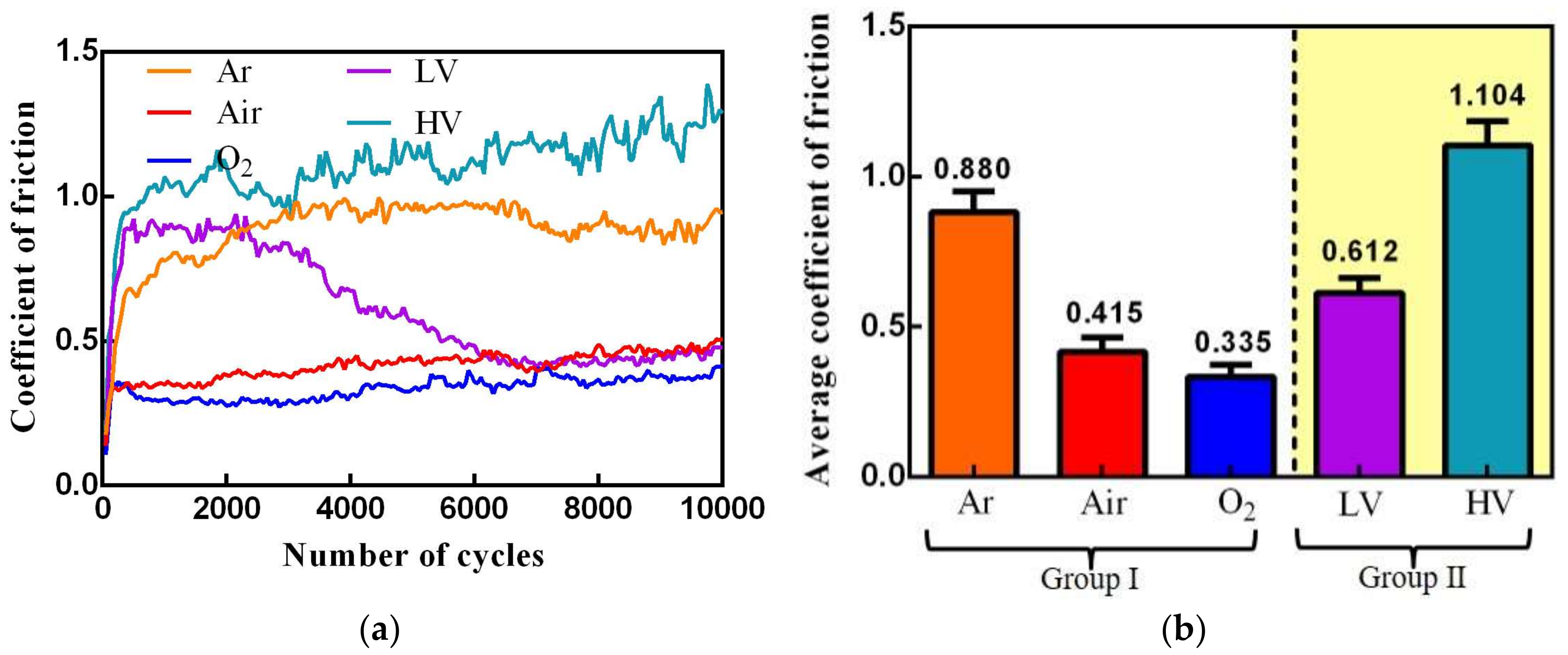
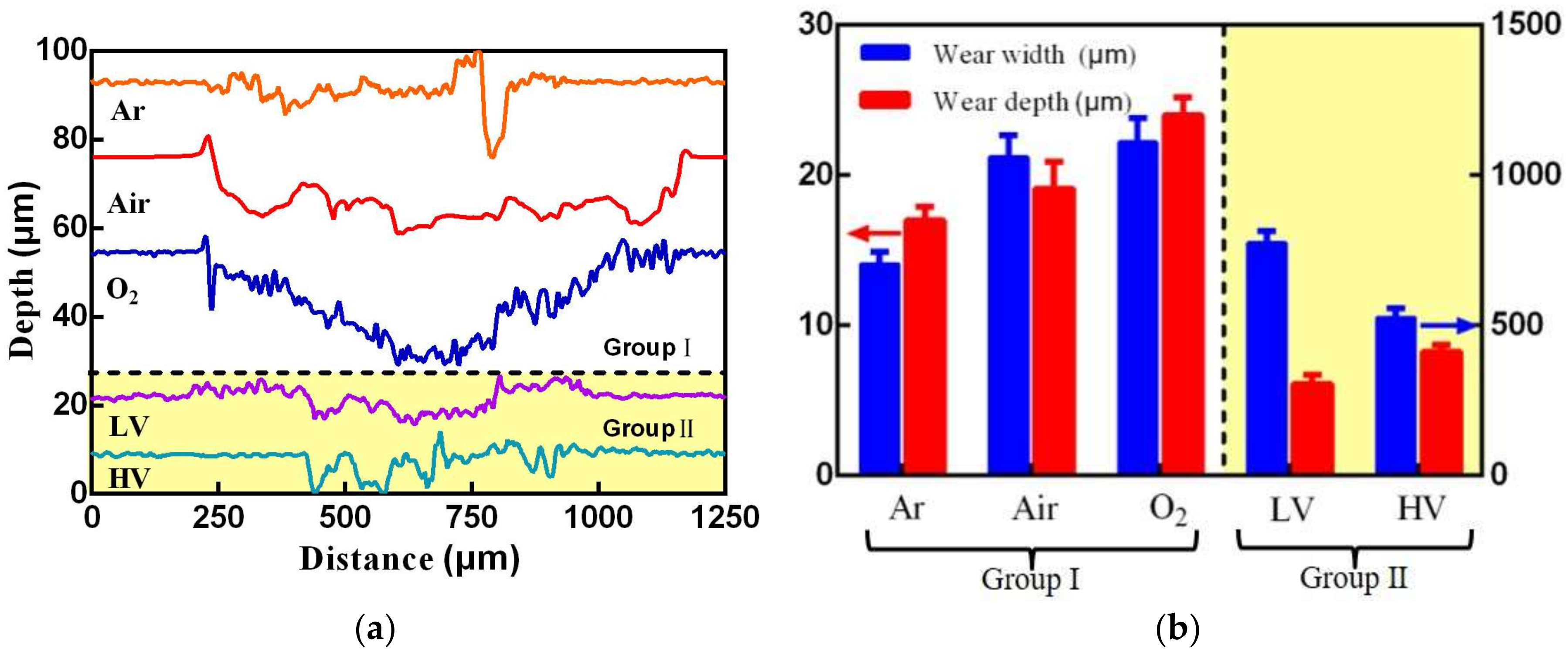
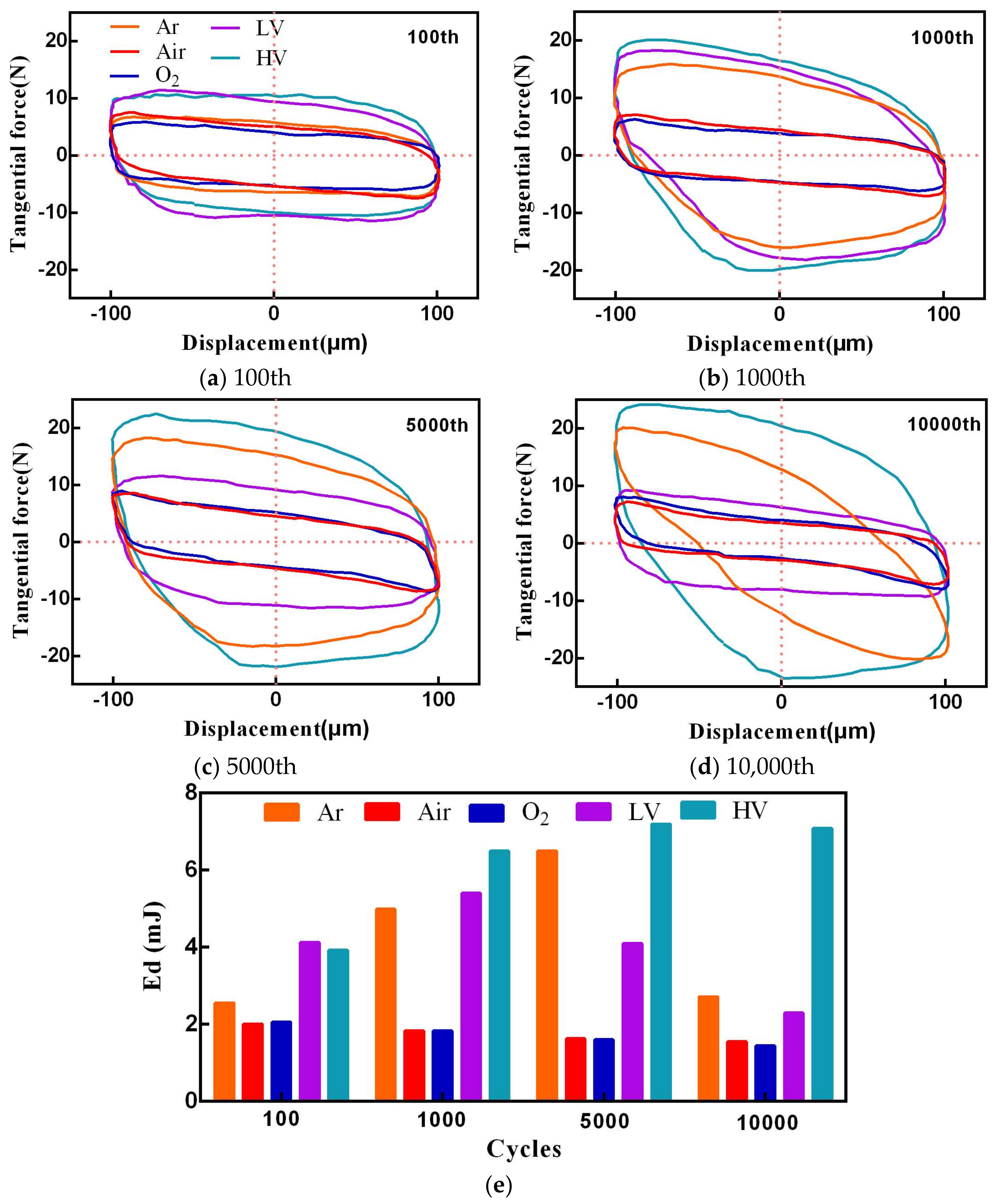

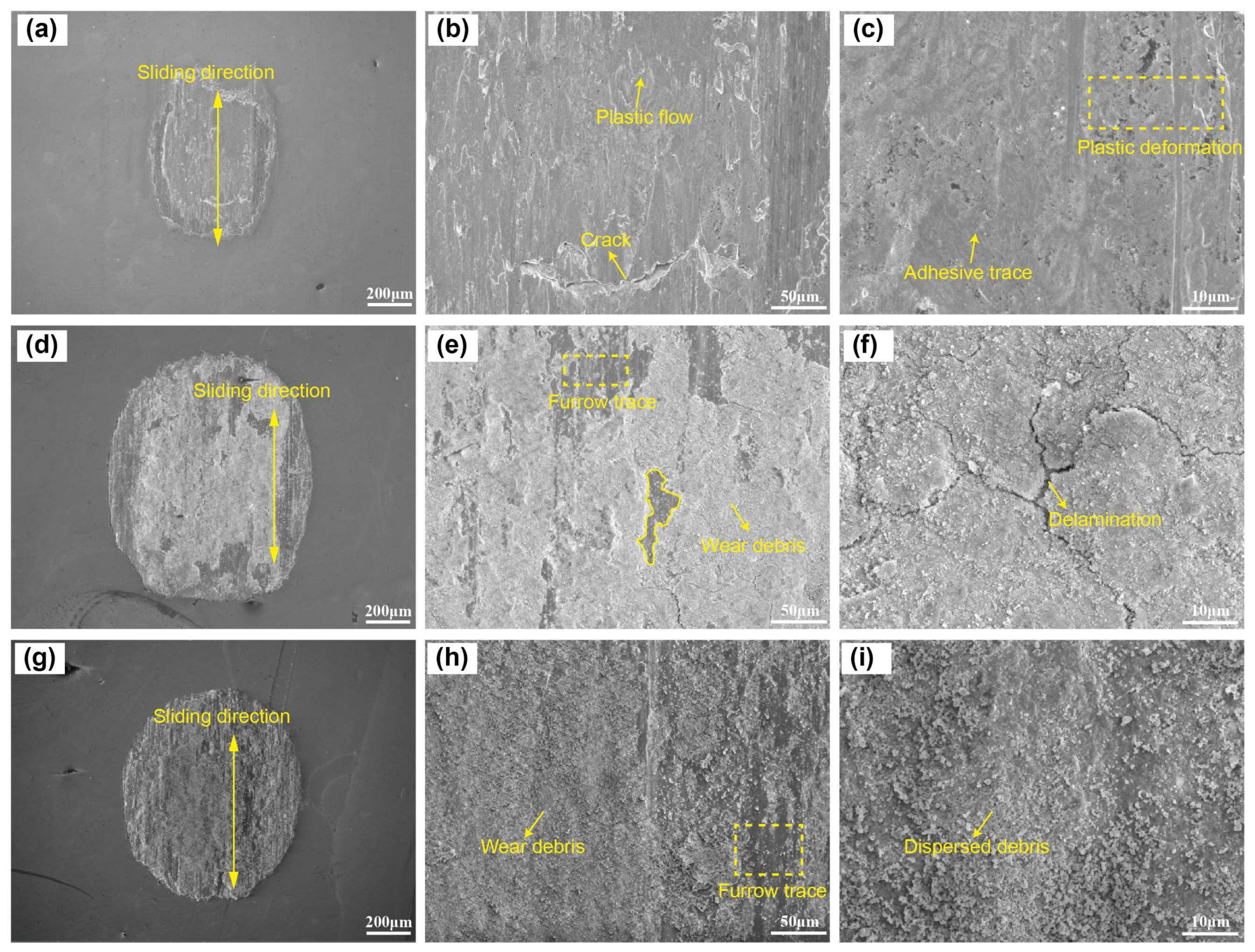
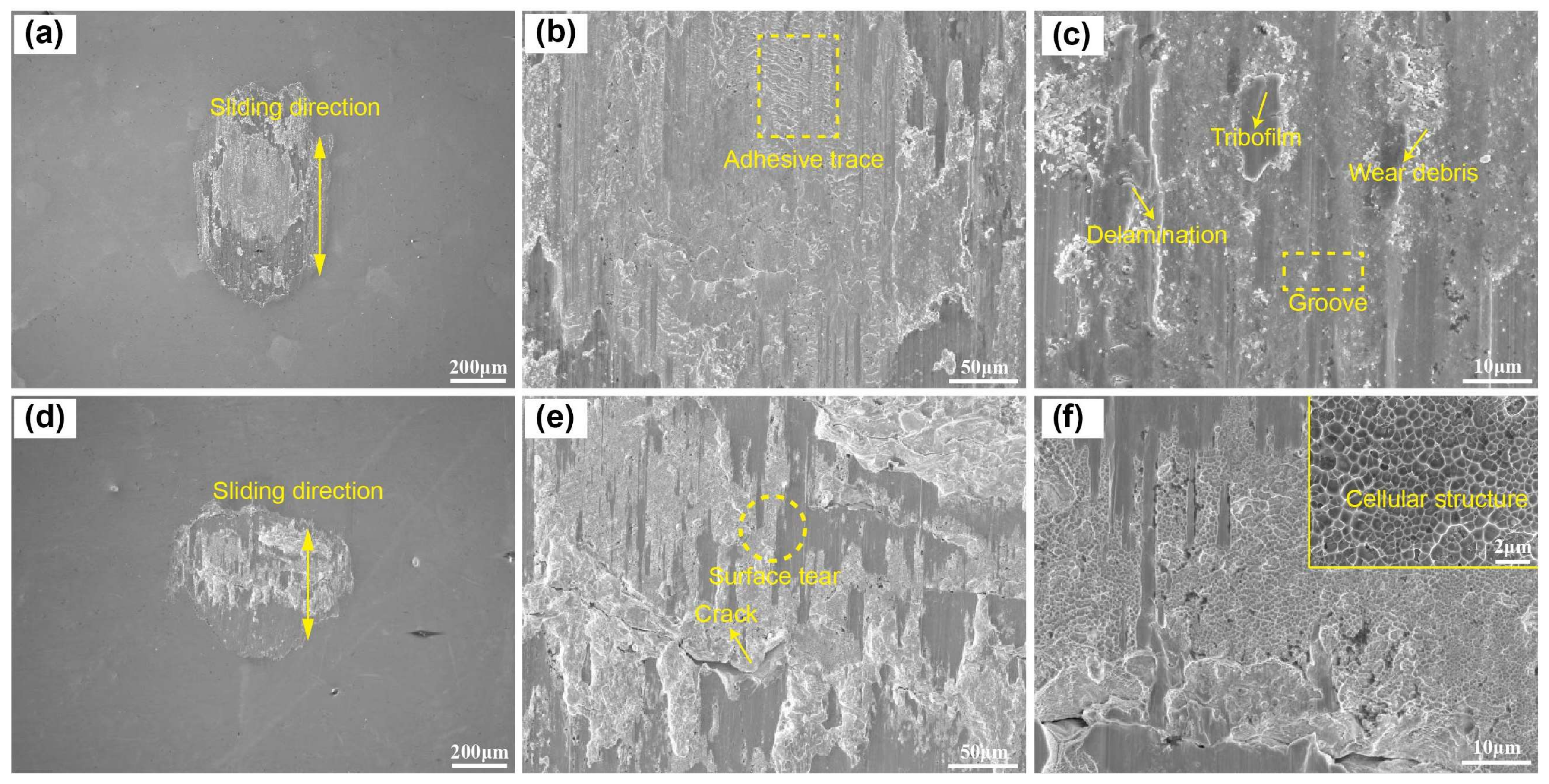
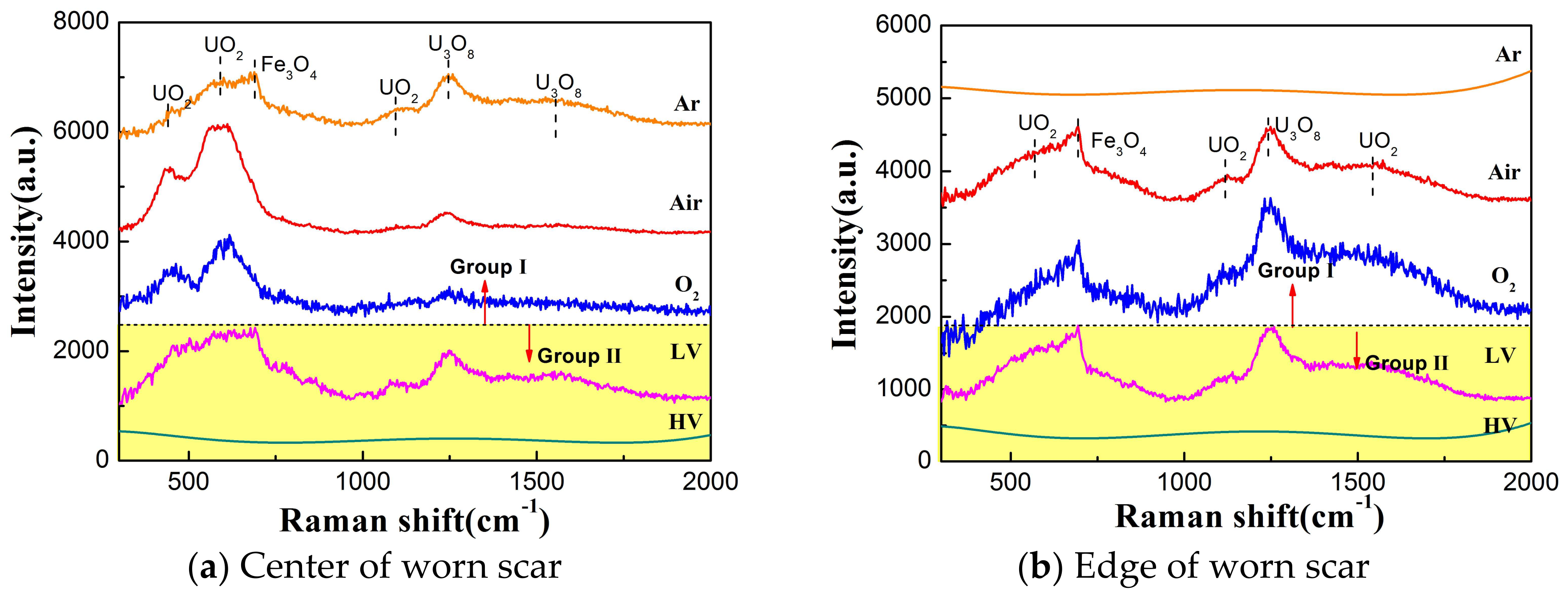
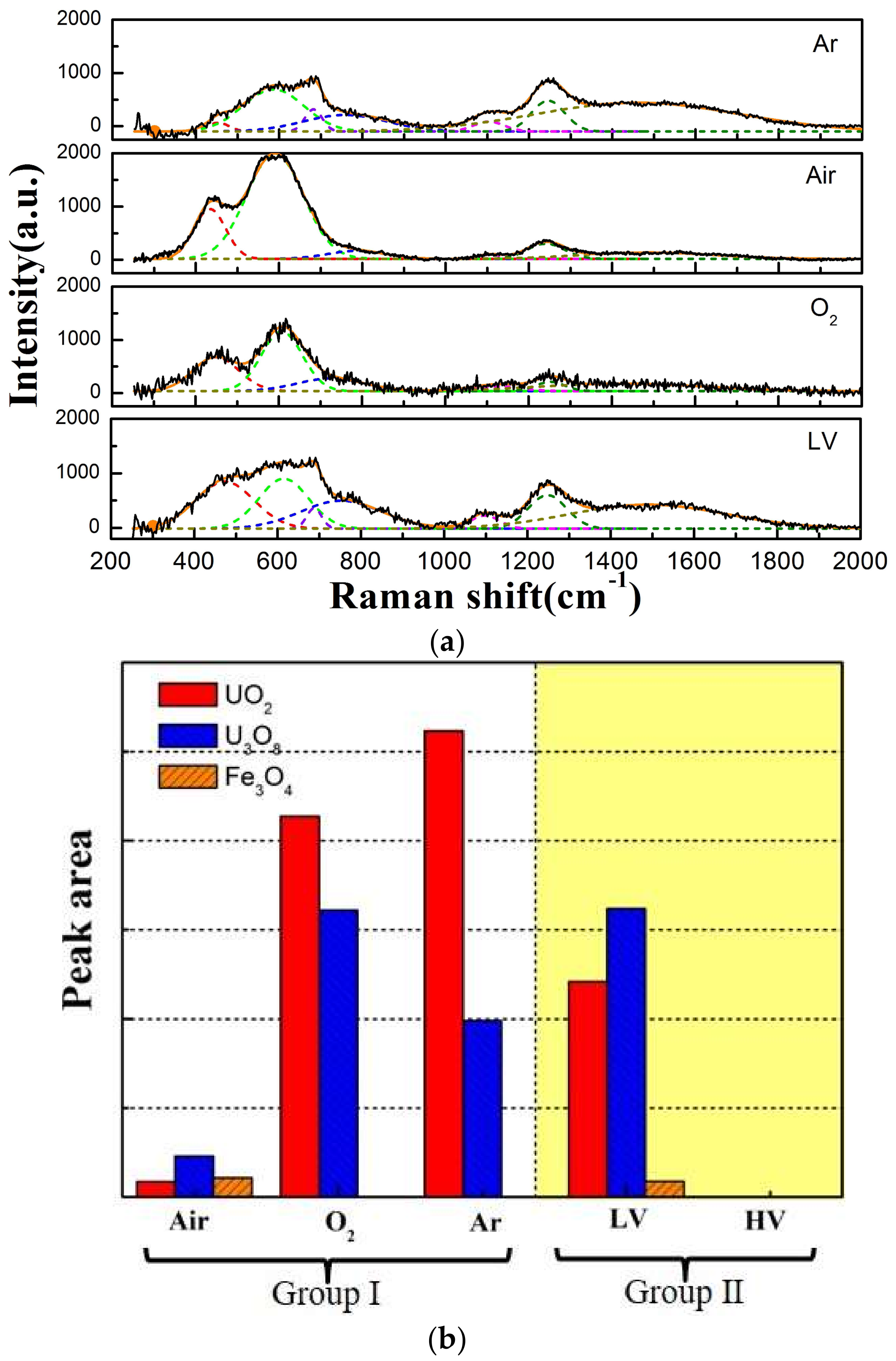

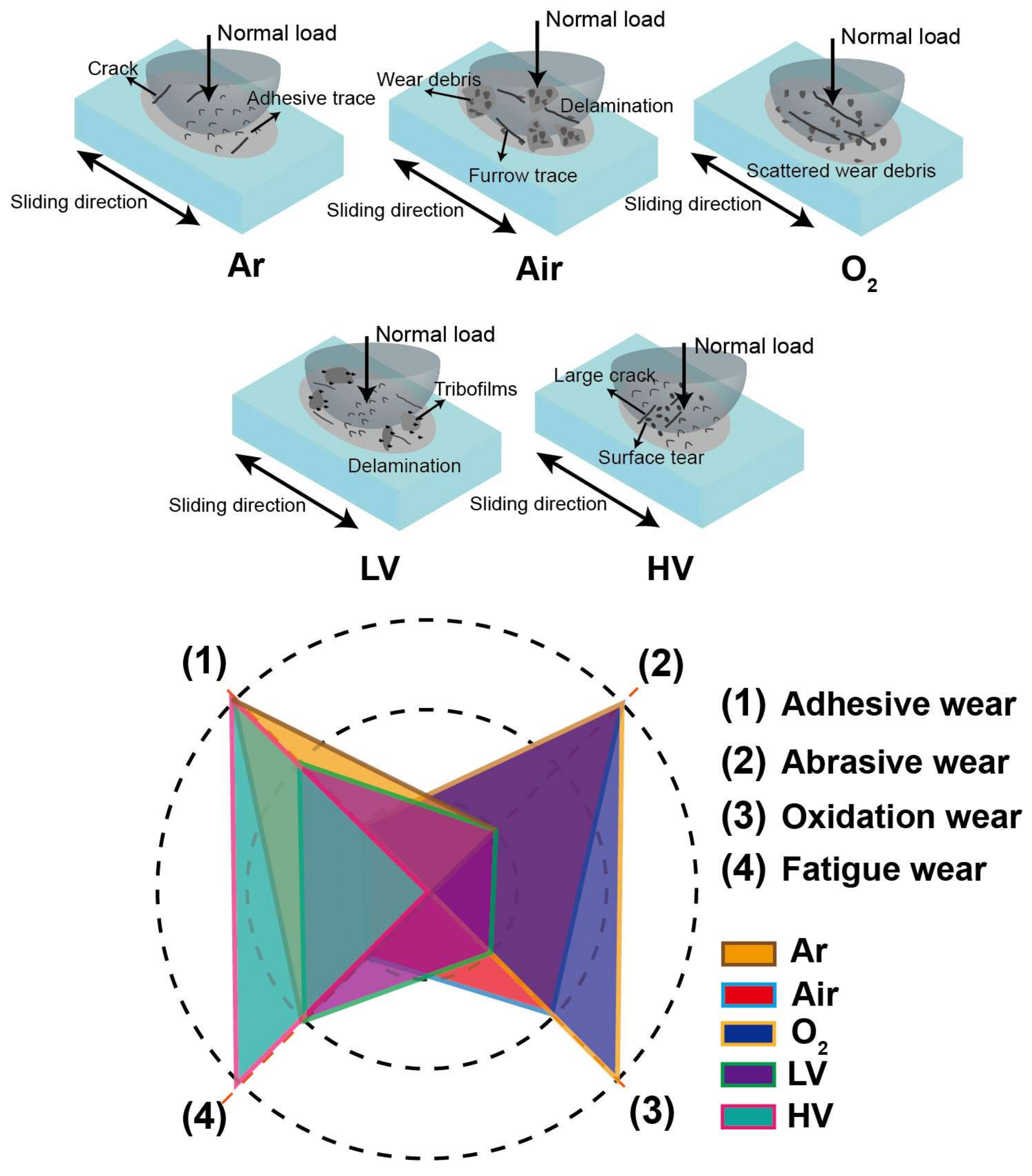
| Group | I | II | |||
|---|---|---|---|---|---|
| Specimen | 1# | 2# | 3# | 4# | 5# |
| Atmosphere | Ar | Air (21% O2 + 78%N2) | O2 | Air | |
| Pressure (Pa) | 1.01 × 105 | 1.05 | 1 × 10−4 | ||
| Displacement amplitude (μm) | 100 | 100 | |||
| Load (N) | 20 | 20 | |||
| Cycle | 104 | 104 | |||
© 2018 by the authors. Licensee MDPI, Basel, Switzerland. This article is an open access article distributed under the terms and conditions of the Creative Commons Attribution (CC BY) license (http://creativecommons.org/licenses/by/4.0/).
Share and Cite
Li, Z.; Cai, Z.; Wu, Y.; Meng, X.; Zhang, D. Fretting Wear Damage Mechanism of Uranium under Various Atmosphere and Vacuum Conditions. Materials 2018, 11, 607. https://doi.org/10.3390/ma11040607
Li Z, Cai Z, Wu Y, Meng X, Zhang D. Fretting Wear Damage Mechanism of Uranium under Various Atmosphere and Vacuum Conditions. Materials. 2018; 11(4):607. https://doi.org/10.3390/ma11040607
Chicago/Turabian StyleLi, Zhengyang, Zhenbing Cai, Yanping Wu, Xiandong Meng, and Dongxu Zhang. 2018. "Fretting Wear Damage Mechanism of Uranium under Various Atmosphere and Vacuum Conditions" Materials 11, no. 4: 607. https://doi.org/10.3390/ma11040607





